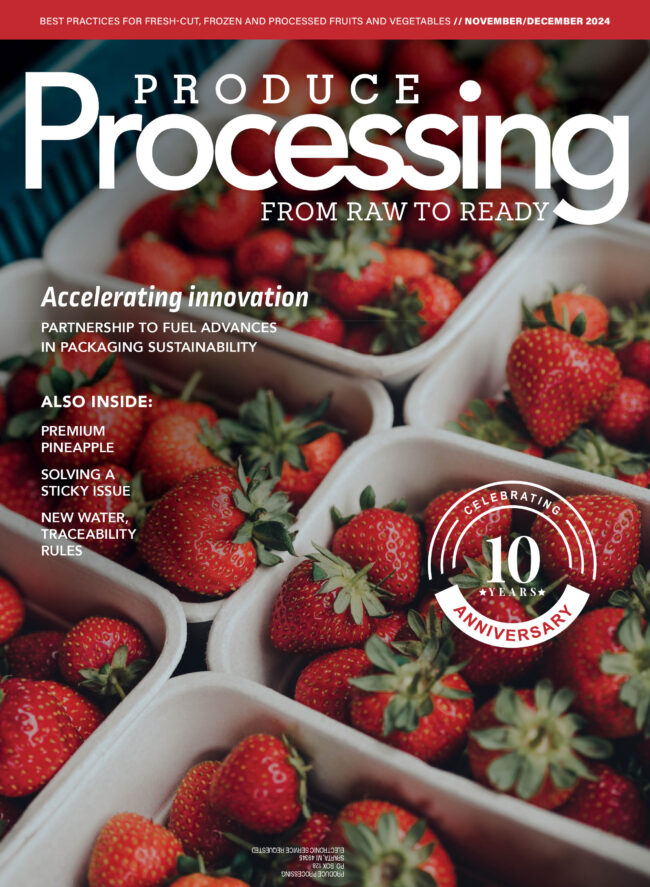Food safety researchers take aim at cyclospora
A handful of Cyclospora cayetanensis outbreaks tied to U.S.-grown produce since 2018 have prompted several researchers to begin looking at possible domestic sources of the pathogen and potential industry risks.
Among those is Mia Mattioli — Ph.D. and an environmental engineer with the Centers for Disease Control and Prevention’s National Center for Emerging and Zoonotic Infectious Diseases — who is leading a two-year project in Georgia.
Not only will the research look at Cyclospora prevalence in surface waters used for agricultural irrigation, but it also will assess the pathogen’s prevalence in on-farm portable toilets and in wastewater influents in Georgia’s Southeastern Coastal Plain growing region. In addition, the researchers will examine water samples for E. coli and a human-specific fecal marker to gain a better understanding of other water contaminants.
“Cyclospora is thought to be rare in the environment,” Mattioli said. “If we can’t find it, we can at least find some useful information about human contamination within these water sources and provide some recommendations to the growers.”
Joining her as co-principal investigators are Michael Arrowood, Ph.D., with the CDC’s Division of Parasitic Diseases; Amy Kahler, a microbiologist with the CDC’s National Center for Emerging and Zoonotic Infection Diseases; and Andre Luiz Biscaia Ribeiro da Silva, Ph.D., with the University of Georgia’s Tifton Campus Extension Program. Also supporting the research is Jess Hofstetter, a parasitologist contractor with Eagle Medical.
Cyclospora has a rather complex life cycle and requires a human host as an intermediary to complete its cycle. An infected human sheds unsporulated — or immature, non-infective — oocysts in their feces. It takes one to two weeks of favorable conditions for the oocyst to mature and become infective. Cyclospora is endemic to many parts of the world, including Central and South America.
With many farmworkers immigrating from those regions, Mattioli wondered whether they could unknowingly bring the pathogen with them. That’s one reason she included testing portable toilets and sewage influent.
Since January 2020, twice-monthly samples of sewage sludge were shipped to CDC laboratories in Atlanta, Georgia. The CDC team is working its way through the samples using microscopy to look for the pathogen.Coronavirus-related shutdowns and travel restrictions delayed the start of on-farm sampling until September 2020. The plan calls for collecting large-volume samples (50 liters) of irrigation water twice monthly during harvest and monthly during other times on eight participating farms.During harvest, they’ll also collect samples of used packinghouse water to analyze for Cyclospora as a proxy for the pathogen’s presence on harvested produce. The wash water also will provide a composite picture and involve many more fields than the researchers could sample individually.
At the project’s onset, the researchers weighed the total number of operations involved against the samples collected per operation and the relevance of the results.
“It’s always a tradeoff when it comes to capacity and the maximum we can cover,” she said. “We’ll be covering southern Georgia. We didn’t want to lose frequency to cover an expanded geographic area.”
Mattioli also pointed to Ynes Ortega, Ph.D., with the University of Georgia, who is conducting a CPS-funded project sampling for the presence of Cyclospora in Florida and California production areas. Together, their results will paint a broader regional picture.
As with the sludge samples, CDC will analyze the water samples for Cyclospora. Should any be detected, the team will determine the genotype and compare the genetic fingerprint to other known populations. The team also will determine the oocyst maturity, which gives an indication of how long ago it was shed by the human host and the potential health risks associated with consumption of contaminated produce.
Mattioli credited da Silva and the long-standing rapport he has with local growers for them opening their doors to the researchers.
“I think what’s been so phenomenal with Andre as an Extension professor at UGA Tifton — and I’ve seen this play out with other university Extension programs — is the implicit trust the growers have in him,” she said. “This is a hot topic, and growers could choose not to look until they have to. But instead, they trust that this is for the betterment of not just the growers but the industry in general. I think this speaks a lot to who they are as growers.”
— Center for Produce Safety







